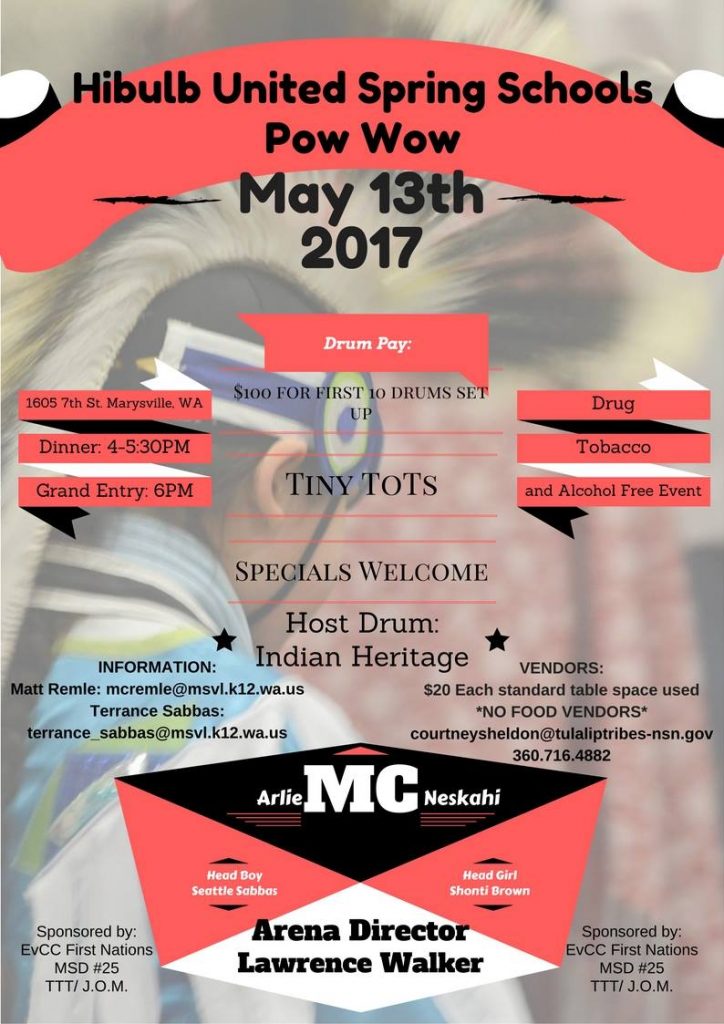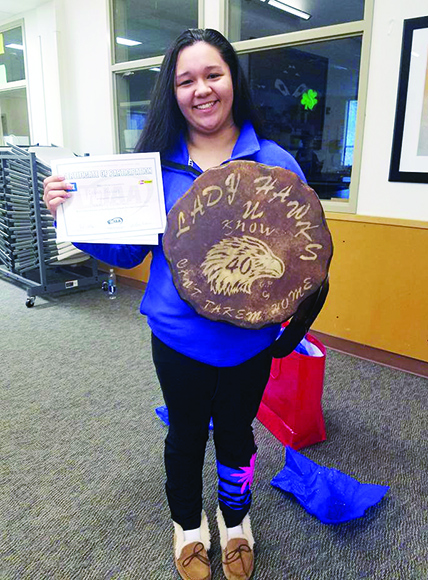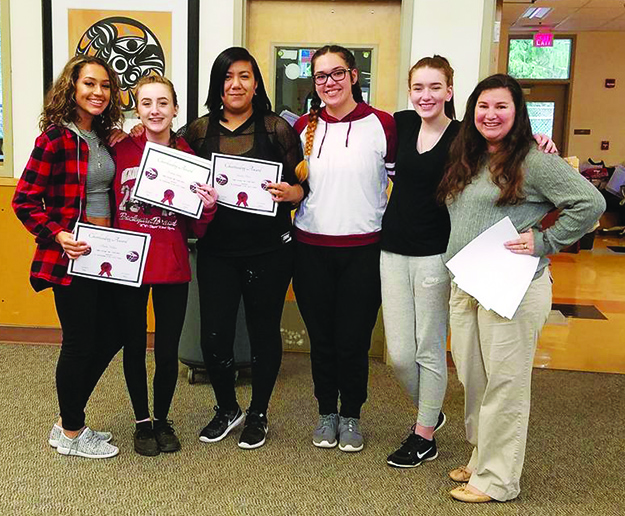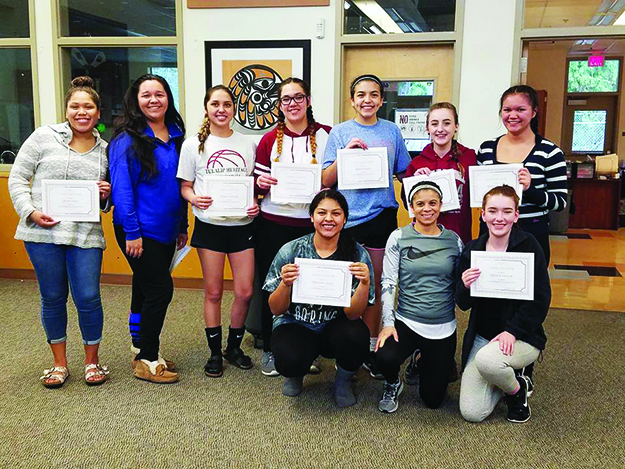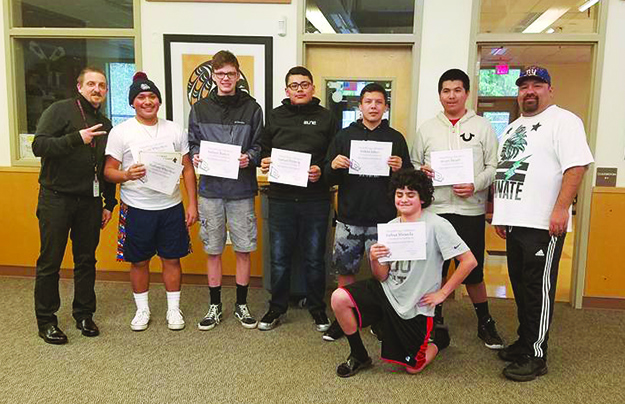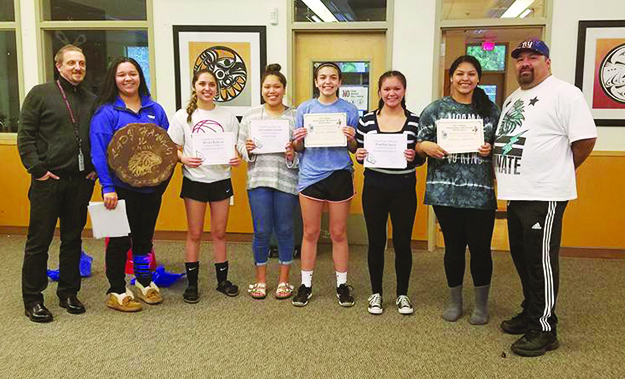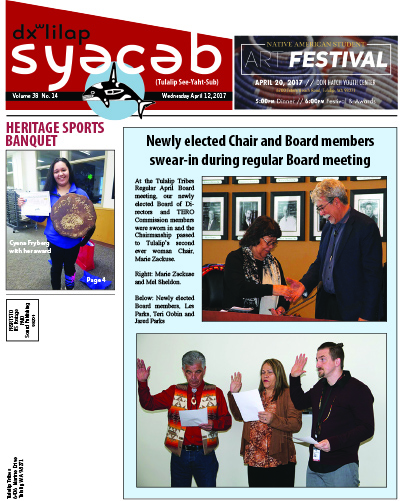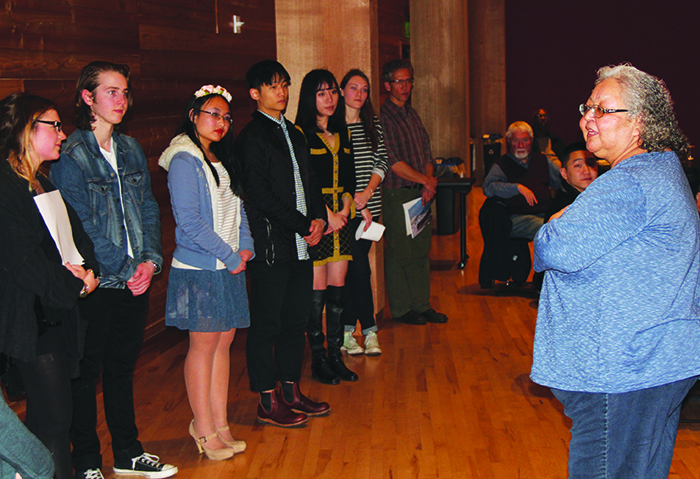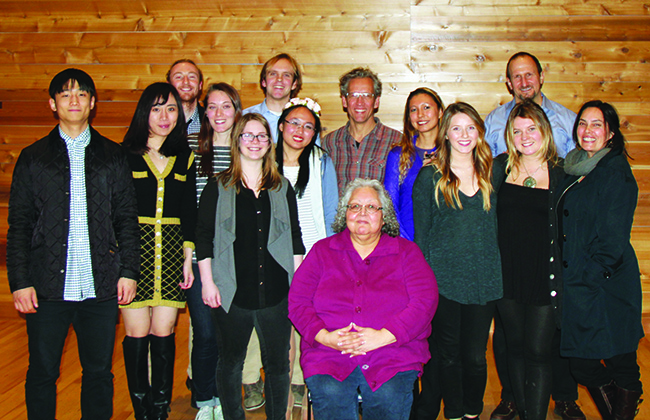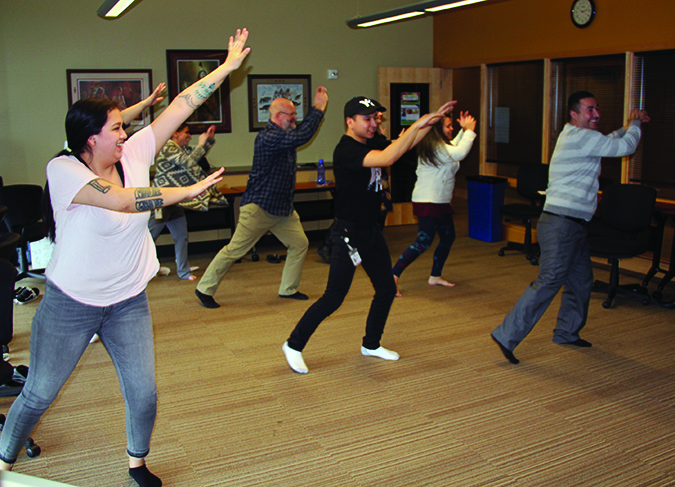Salmon Ceremony practice begins April 20 and continues every Thursday until the event. Practice is 5:30 p.m. at the Kenny Moses Building.
Author: Kim Kalliber
Memorial Day at Tulalip, May 29
Real Talk Wednesdays
Annual Tulalip War Canoe Races, May 6-7
Hibulb United Spring Schools Pow Wow, May 13
Celebrating athletic accomplishment
By Micheal Rios, Tulalip News; photos courtesy Heritage H.S.
Tulalip Heritage High School faculty and coaches honored their Fall and Winter sports participants with a joint celebration and banquet-style potluck on Wednesday, March 29 in the Heritage Commons.
With friends and family in attendance, the players took center stage and received recognition for their dedication to practice, constant improvement and teamwork during the sports season.
Bringing cheer and halftime entertainment to every home and playoff game were the Heritage cheerleaders. They always kept a positive attitude, smiles on their faces, and were determined to keep the home crowds upbeat.
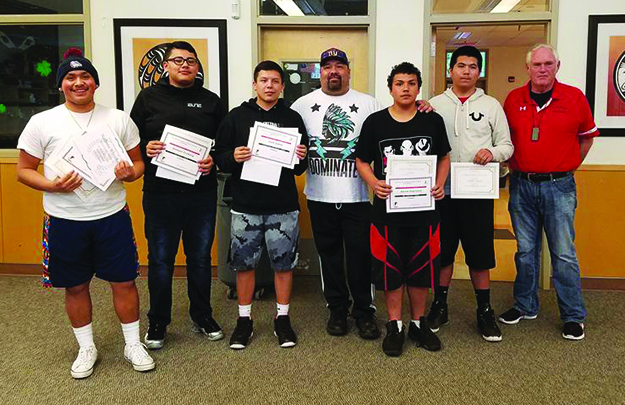 The Hawks football team was short on eligible players this past season, but that didn’t stop them from showing up come game day and leaving their all on the field. After a narrow 2-point loss in their opening game, the football program showed out the very next game for a 51-26 victory in front of the home crowd.
The Hawks football team was short on eligible players this past season, but that didn’t stop them from showing up come game day and leaving their all on the field. After a narrow 2-point loss in their opening game, the football program showed out the very next game for a 51-26 victory in front of the home crowd.
Lady Hawks volleyball had another productive season under coach Tina Brown. The girls opened the season with five straight victories on their way to a 9-6 regular season record and a trip to the postseason. At the 1B District playoffs, they dropped their first match before bouncing back with back-to-back Ws and earning a trip to Tri-Districts.
Coaches Marlin and Cyrus “Bubba” Fryberg made the best of a rebuilding year for their boys basketball program. With so many new faces on the team there was a steep learning curve. The Hawks opened the season 1-6, but soon after found their identity and went 7-5 down the stretch to clinch a playoff spot. In the postseason, the boys played their best basketball and defeated two teams with better records to earn a Tri-District berth.
The Lady Hawks basketball program achieved the most this year. The girls carried a stellar record all season long on their way to battling for the NW1B regular season crown. Led by their Big 3 (Aliya Jones, Keryn Parks, and Deandra Grant), they finished the regular season 16-3. With two decisive victories to open the playoffs, the Lady Hawks matched up with inner-league foe Cedar Park Christian for the third time in the NW1B championship game. Back and forth for nearly the whole game, Cedar Park pulled away in the final minutes. It was a heartbreaking game for the Lady Hawks, but they bounced back admirably to win two more games at Tri-Districts and clinched consecutive trips to Regionals.
Coach Bubba Fryberg was recognized as Coach of the Year in the Northwest 1B League, while three of his players (Aliya, Keryn, and Deandra) were named to the All-League 1st Team. Additionally, Aliya earned All-State recognition with an honorable mention by the Associated Press.
April 12, 2017 syəcəb
Please use the following link to download the April 12, 2017 issue of the syəcəb: https://www.dropbox.com/s/sbi3gq88atzad7s/April%2012%202017%20sy%C9%99c%C9%99b.pdf?dl=0
Tulalip sovereignty & environmental recovery efforts recognized by UW
By Micheal Rios, Tulalip News
Tribal sovereignty, the inherent authority of indigenous tribes to govern themselves within the borders of the United States, is an all too understood and often used concept in Native America, yet remains relatively foreign to outside communities. In the Digital Age, characterized by a highly diverse free flow of information on every topic imaginable and an endless supply of avenues for acquiring knowledge, recognition of tribal sovereignty and awareness of treaty rights remain hidden from the mainstream and absent from the United States’ public consciousness.
That’s not to say there aren’t very socially aware individuals and communities who have made it their mission to bring understanding of tribal sovereignty to the mainstream. One such individual is Professor Patrick Christie of University of Washington’s heralded Jackson School of International Studies. Professor Christie recently taught an undergraduate class showcasing Tulalip’s tribal sovereignty and treaty rights. The class specifically emphasized the Tulalip Tribe’s environmental recovery efforts, such as the Qwuloolt Estuary Restoration Project and salmon recovery initiatives.
A unique feature of the International Studies Program is the Task Force capstone course that Professor Christie taught. This Task Force requires students to team together to research a specific policy issue and offer a set of recommendations. Many students cite this course as the highlight of their undergraduate education. For the first time in program history, a Native American tribe was selected as the subject of international study.
“This is the very first international studies Task Force had ever done within the continental United States. The idea is to say ‘international study’ doesn’t just mean Russian foreign policy or Chinese foreign policy, it’s whenever the United States government and society interacts with sovereign nations. This idea raises awareness and changes the political landscape as it relates to tribal policy,” explains Professor Christie. This simple yet well-expressed notion can completely change attitudes and mindsets as they relate to tribal relations within U.S. borders. Recognizing tribes as independent, sovereign governments as we would a foreign country is where the awareness begins.
The Task Force was composed of fifteen International Studies undergraduates from various cultures and backgrounds. During their course study and research, these students read a mass amount of literature relating to treaty rights in order to build a foundation for understanding. This literature included the 1855 Treaty of Point Elliot, the Boldt Decision and Rafeedie Decision court cases, and Where the Salmon Run: The Life and Legacy of Billy Frank Jr. Taking their learning a step further, the Task Force students visited the Tulalip Reservation and diligently acquired knowledge and further context from Tulalip government employees Inez Bill, Rediscovery Coordinator for the Hibulb Cultural Center, Todd Zackey, Marine Program Manager, and Francesca Hillery, Public Affairs Manager.
“It was really significant to me hearing Inez Bill talk about their land. Tribal members and their ancestors have lived on the land for far, far longer than we have,” shares student Kris Thompson, a member of the International Studies Task Force, on his experience visiting the Hibulb Cultural Center. “People move in and out of Seattle on a monthly basis. The Tulalip people have been here forever, they are here now, and they will stay here. They have a connection to the environment that I don’t think any of us can really understand.”
Concluding the three-month course focusing on Tulalip treaty rights and environmental recovery efforts was a gathering to celebrate and present the thought provoking work the student Task Force had developed. Among attendees were Tulalip tribal members Inez Bill and Maria Martin, Lushootseed language teacher. Maria provided a traditional prayer to begin the occasion, while Inez shared her eloquent words to end the evening.
“I raise my hands to the students who had the open minds to take the time to do the necessary research and background work. I raise my hands to them for having an open heart to learn who we are as a people during their visits to our tribe and reservation,” announced Inez to all those in attendance. “I hope we can continue to bridge communication and share an open understanding of how our world is today. I thank you all for opening your heart and your minds to the needs of our people and seeing who we are.”
15-minute bodyweight workout for the win
By Micheal Rios, Tulalip News
Whether you are a busy professional, student, or a stay at home parent, a 15-minute bodyweight workout can be the perfect solution for your exercise needs. Designed to be done pretty much anywhere with no fitness equipment and in enough time to squeeze into a customary work break, super short but non-stop workouts can be very effective for building strength and cardio endurance.
It may just be 15 short minutes, but the key is to make the workout intense by getting through each exercise as quickly as you can with minimal rest. If you want to make the workout longer, simply add more sets.
This workout style was demonstrated at the latest Wellness Wednesday, which takes place every Wednesday at 2:00 p.m. in room 264 at the Tulalip Tribes Admin Building. The 1st and 3rd Wednesdays of each month are designated to healthy cooking demonstration, while the 2nd and 4th Wednesdays of every month are to teach the basic fundamentals of everyday fitness. Brought to you by SNAP-ED Coordinator AnneCherise Jensen, this free fitness demonstration is great exercise for anyone regardless of fitness level.
“Getting at least 15-minutes of intense exercise every day is one of the best ways to prevent chronic diseases from developing over time. Like they say, exercise really is the best medicine!” proclaims AnneCherise. “Getting in a 15-minute exercise will help you burn more calories throughout the day that will help you maintain a healthy body weight. Fifteen minutes of exercise will help stimulate various brain chemicals making you feel happier and more relaxed throughout the day.
“Studies have shown that exercising regularly helps manage both anxiety and depression. A 15-minute exercise will get the heart rate up, which will naturally help prevent against heart disease and regulate good blood cholesterol. For those who are sedentary throughout the day and generally sit at a desk all day, getting in at least 15-minutes of exercise is especially important for obtaining good health.”
Among the Wellness Wednesday participants were tribal members and sisters, Shelbi and Celum Hatch. Following the short, intense workout Shelbi’s reaction was, “It was fun. The convenience is pretty ideal to have this offered at work because my issue lately is I can’t make it to the gym after work, can’t make it before, and if I do make it at lunch there’s barely enough time to get a workout in.”
Cooling down from the workout and feeling the immediate effects Celum added, “Yeah, my heart is racing pretty good and I have a good sweat going, so that proves the workout was effective. I thought it was a good class. It was convenient with location and time.”
This particular 15-minute workout will hit many of the different muscles in your core and legs. Get ready to work your obliques, lower abs, triceps, calves, hammies, and glutes. Working the muscles of your legs and the abs helps you maintain balance, good posture, and an overall strong physique. Plus, bodyweight exercises can challenge more of the body than a supported weight workout might. Here is a breakdown of the workout completed during the Wellness Wednesday fitness demo.
Warm Up: (2-3 minutes)
- 5 jumping jacks
- 5 push ups
- 5 sit ups
Routine: (8-10 minutes)
- 60 seconds: Stretching
- 30 seconds: Marching
- 30 seconds: Stepping side to side with torso rotations
- 30 seconds: Stepping side to side, kicking high knees, bringing arms up and down with each high knee.
- 30 seconds: Step Touch, moving arms up and down with each step.
- 30 seconds: Squat in place, keeping your spine and shoulders back.
- 30 seconds: Marching with hands moving back and forth
- 30 seconds: Stepping feet back to back while doing bicep curls with arms.
- 30 seconds: Stepping feet back to back while doing triceps curls with arms.
- 30 seconds: Marching with hands moving back and forth
- 30 seconds: Stepping side to side, taking left elbow to right knee, and right knee to left elbow.
- 30 seconds: Marching at a fast pace with various arm rotations.
- 30 seconds: Step to step, tapping right hand to inside of your left ankle, then left hand to right ankle.
- 30 seconds: Stepping side to side, pulling arms back at all times, with left calf back then right calf back.
- 30 seconds: Multiple Squats while reaching your hands up and down.
- 60 seconds: 20 jumping jacks
Cool Down: (2-3 minutes)
- 30 seconds: Marching slowly in place
- 30 second: Toe touch, head down, stretch the hamstrings.
- 30 seconds: Standing side to side torso rotations
- 60 seconds: Various yoga stretches
Reminders:
- Always remember to breathe in and out. Good breathing is key to a successful workout
- The more you move your arms throughout workout, the better the cardio workout. Remember, don’t stop moving!
- Do this at your own fitness level; feel free to modify it to whatever you feel comfortable with. You don’t want to overdo it and hurt yourself.
- Be sure to put on some up-beat music to get the energy flowing.




